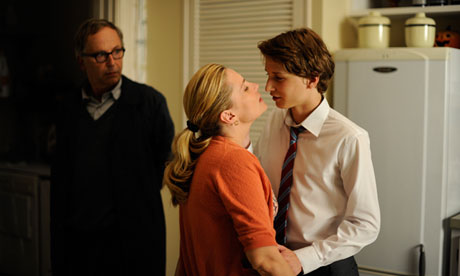
The 45-year-old François Ozon has made a dozen feature-length films and several shorts over the past 15 years, and he has found a popular audience in France for stylish, sophisticated movies that often deal with gay themes. Unlike the work of most French mainstream directors, a fair proportion of his pictures have crossed the Channel. Moreover, he's worked with several prominent British actresses – most notably Charlotte Rampling, Kristin Scott Thomas and Romola Garai, the last named having appeared in his version of Elizabeth Taylor's novel Angel playing a romantic novelist in Edwardian England.
Ozon's new film, the teasing comedy In the House, touches on a number of his recurrent concerns, among them the nature of creativity and stories within stories, and it is, I think, his best work to date. Loosely based on a Spanish play by Juan Mayorga called The Boy in the Last Row, it's set in a secondary school in an unidentified French town where the intense, prissy, humourless Germain teaches literature. Married without children and in his mid-50s, he's played by Fabrice Luchini, a great actor who made several pictures with Eric Rohmer before giving his finest performance as the wily lawyer in a corrupt 1817 Paris in a film of Balzac's Colonel Chabert. Most recently he played Catherine Deneuve's domineering husband in the comedy Potiche.
Germain despises most of his fellow teachers for their conventional thinking and despairs of his pupils for their uniformity and lack of imagination. His wife, Jeanne (the excellent Kristin Scott Thomas), who runs a would-be fashionable avant-garde art gallery called the Minotaur's Maze, tolerates his querulous pessimism. And she counters his belief in the life-enhancing, therapeutic effects of literature by evoking the influence of The Catcher in the Rye on Mark David Chapman, John Lennon's assassin. Suddenly, Germain discovers a gifted pupil, the 16-year-old Claude (the handsome newcomer Ernst Umhauer), who turns in an essay on "What I did last week". Unlike the other kids in the class, who hand in a few bored, illiterate lines, Claude writes of his fascination with a fellow pupil, the attractive, sports-loving Rapha, and his seemingly perfect middle-class life with adoring parents, Rapha senior and the attractive Esther. They're so ordinary, so typical, so different from Claude's own broken family. Germain is grabbed by the mixture of affection and satire in Claude's paper, and particularly by the phrase "the singular smell of a middle-class woman" used by the 16-year-old schoolboy to describe the mother. He encourages Claude to chronicle their lives, to insinuate himself into Rapha's household as observer and catalyst. Steadily he becomes obsessed with the story of the family and the development of Claude's literary style and eggs him on.
Pupil and teacher, as both seducer and seduced, enter into a form of conspiracy. Life and literature become almost indistinguishable, as they do for the British writer in Ozon's Swimming Pool. The results are extremely funny in the account of a folie à deux in the dangerous world of teaching, and perceptive in the observation of the creative process. They're also tragic, both professionally and personally: Germain heads inexorably for disaster as a teacher and a husband. His relationship with Claude leads his neglected wife to suspect that his sexual orientation has changed, and appropriately enough she stuns him using a hardcover edition of Céline's Voyage au bout de la nuit.
There is from the start another, more elaborate story lurking beneath this clever psychological comedy of teaching and erotic obsession. The movie begins by showing the school – an austere modernist building of glass and concrete called the Lycée Gustave Flaubert, an invocation of the writer dedicated to making the perfect fiction that has the force and form of life itself. It gradually becomes evident that the film can be read as something going on in the mind of a man wholly preoccupied by the problems of making a work of art, someone who has on his mind Graham Greene's cruel precept that "There is a splinter of ice in the heart of a writer". Very obliquely we learn that Germain's given name is Claude, and that he himself is the author of an unsuccessful novel and haunted by its failure.
The movie's title, In the House, clearly refers not only to the home of Rapha and his family that Claude is exploring but also to the famous "house of fiction" that Henry James wrote about in his 1908 preface to The Portrait of a Lady. "The house of fiction has in short not one window but a million," he wrote, and went on to say that "every one of which has to be pierced, or is still pierceable on its vast front, by the need of the individual vision and by the pressure of the individual will." James had earlier, in a 1902 essay, spoken of Madame Bovary and called Flaubert "the novelist's novelist". "Are we not moreover – and let it pass this time as a happy hope! – pretty well all novelists now?" he asked.
The most striking image in In the House has the young Claude and a deranged Germain gazing across a garden at a balcony on which two middle-aged women are talking volubly, though their speech cannot be heard. Who are they? What is their relationship? What is their story? The observers immediately enter into a competition, imposing narratives upon the two women. Night falls, the camera draws back and we see the whole apartment block, three floors of it, a dozen windows, modelled precisely as on the set of Hitchcock's Rear Window. Each is an entrance into the house of fiction revealing a different story. The director and the audience are drawn together as voyeurs imposing our narratives on what we see on the screen as we do when organising the world around us.

